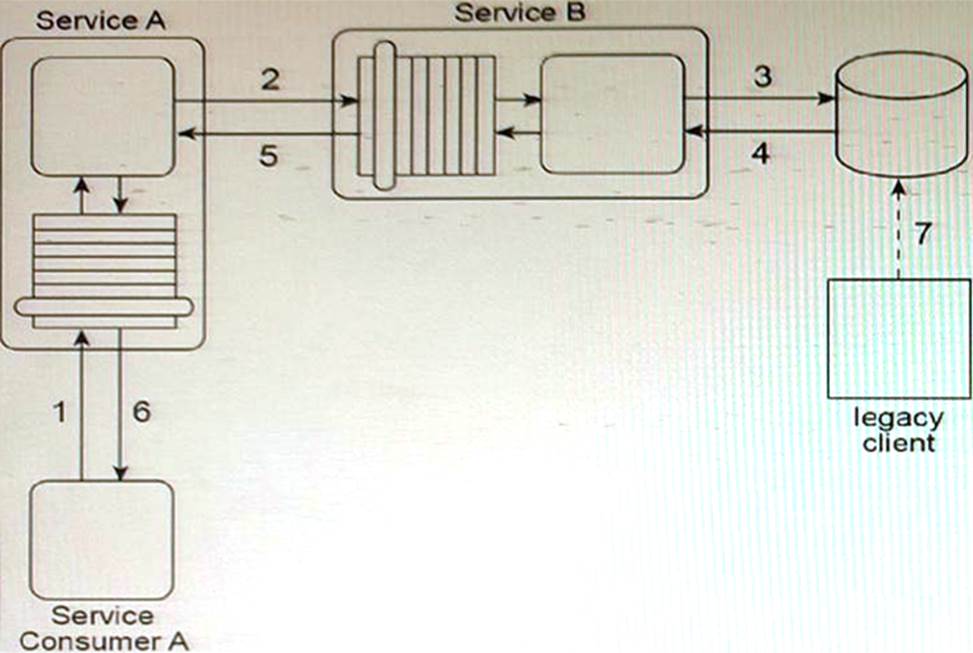What steps can be taken to solve this problem?
Service A is an entity service that provides a Get capability which returns a data value that is frequently changed.

Service Consumer A invokes Service A in order to request this data value (1). For Service A to carry out this request, it must invoke Service B (2), a utility service that interacts (3, 4) with the database in which the data value is stored. Regardless of whether the data value changed, Service B returns the latest value to Service A (5), and Service A returns the latest value to Service Consumer A (6).
The data value is changed when the legacy client program updates the database (7). When this change will occur is not predictable. Note also that Service A and Service B are not always available at the same time.
Any time the data value changes, Service Consumer A needs to receive It as soon as possible. Therefore, Service Consumer A initiates the message exchange shown In the figure several times a day. When it receives the same data value as before, the response from Service A Is ignored. When Service A provides an updated data value, Service Consumer A can process it to carry out its task.
The current service composition architecture is using up too many resources due to the repeated invocation of Service A by Service Consumer A and the resulting message exchanges that occur with each invocation.
What steps can be taken to solve this problem?
A. The Event-Driven Messaging pattern can be applied by establishing a subscriber-publisher relationship between Service A and Service
B. This way, every time the data value is updated, an event is triggered and Service B, acting as the publisher, can notify Service A, which acts as the subscriber. The Asynchronous Queuing pattern can be applied between Service A and Service B so that the event notification message sent out by Service B will be received by Service A, even when Service A is unavailable.
B. The Event-Driven Messaging pattern can be applied by establishing a subscriber-publisher relationship between Service Consumer A and Service
A. This way, every time the data value is updated, an event is triggered and Service A, acting as the publisher, can notify Service Consumer A, which acts as the subscriber. The Asynchronous Queuing pattern can be applied between Service Consumer A and Service A so that the event notification message sent out by Service A will be received by Service Consumer A, even when Service Consumer A is unavailable.
C. The Asynchronous Queuing pattern can be applied so that messaging queues are established between Service A and Service B and between Service Consumer A and Service A. This way, messages are never lost due to the unavailability of Service A or Service B.
D. The Event-Driven Messaging pattern can be applied by establishing a subscriber-publisher relationship between Service Consumer A and a database monitoring agent introduced through the application of the Service Agent pattern. The database monitoring agent monitors updates made by the legacy client to the database. This way, every time the data value is updated, an event is triggered and the database monitoring agent, acting as the publisher, can notify Service Consumer A, which acts as the subscriber. The Asynchronous Queuing pattern can be applied between Service Consumer A and the database monitoring agent so that the event notification message sent out by the database monitoring agent will be received by Service Consumer A, even when Service Consumer A is unavailable.
Answer: A
Explanation:
This solution is the most appropriate one among the options presented. By using the Event-Driven Messaging pattern, Service A can be notified of changes to the data value without having to be invoked repeatedly by Service Consumer A, which reduces the resources required for message exchange. Asynchronous Queuing ensures that the event notification message is not lost due to the unavailability of Service A or Service B. This approach improves the efficiency of the service composition architecture.
Latest S90.08B Dumps Valid Version with 17 Q&As
Latest And Valid Q&A | Instant Download | Once Fail, Full Refund

